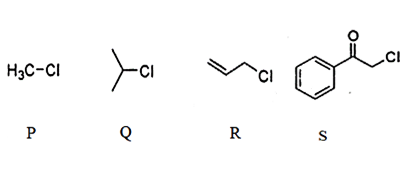(i) chlorobenzene is mon-nitrated to M
(ii) nitrobenezene is mono-chlorinated to N
(iii) anisole is mono-nitrated to P
9iv) 2-nitrochlorobenzene is mon-nitrated to Q.
out of M, N, P and Q the compound that undergoes reaction with aq. NaOH fastest is
M
N
P
Q
The correct Answer is:D
Step by step video, text & image solution for (i) chlorobenzene is mon-nitrated to M (ii) nitrobenezene is mono-chlorinated to N (iii) anisole is mono-nitrated to P 9iv) 2-nitrochlorobenzene is mon-nitrated to Q. out of M, N, P and Q the compound that undergoes reaction with aq. NaOH fastest is by Chemistry experts to help you in doubts & scoring excellent marks in Class 12 exams.
Updated on:21/07/2023Topper's Solved these Questions
- AROMATIC COMPOUNDSBOOK - MS CHOUHANCHAPTER - AROMATIC COMPOUNDSEXERCISE - Level 1 (Q.31 To Q.60)
1 Videos
- AROMATIC COMPOUNDSBOOK - MS CHOUHANCHAPTER - AROMATIC COMPOUNDSEXERCISE - Level 1 (Q.121 To Q.150)
3 Videos
- AN INTRODUCTION TO ORGANIC REACTIONS AND THEIR MECHANISMS ACIDS AND BASESBOOK - MS CHOUHANCHAPTER - AN INTRODUCTION TO ORGANIC REACTIONS AND THEIR MECHANISMS ACIDS AND BASESEXERCISE - ADDITIONAL QUESTION (SINGLE CORRECT CHOICE TYPE )
32 Videos
- BIOMOLECULESBOOK - MS CHOUHANCHAPTER - BIOMOLECULESEXERCISE - Level 2
1 Videos
Similar Questions
Kl in acetone , undergoes SN2 reaction with each of P,Q,R,and S The rates of the reaction vary as

View SolutionWrite the product(s) formed when
(i) 2-Bromopropane undergoes dehydrohalogenation reaction.
(ii) Chlorobenzene undergoes nitration reaction.
(iii) Methylbromide is treated with KCN.
View Solution
Knowledge Check
(i) 'P×Q' means 'P is the brother of Q'.
(ii) 'P÷Q' means 'P is the sister of Q '.
(iii) 'P+Q' means 'P is the father of Q'.
(iv) 'P-Q' means 'P is the mother of Q'.
Which of the following represent 'M is nephew of N' ?AN−K+MBN×K÷M÷TCN÷K×MDN÷K+M×TIn the following question , the symbols @ , c , $, % and * are used with the following meanings as illustrated below :
'P © Q' means P is not smaller than Q
'P ∗ Q' means P is not greater than Q.
'P @ Q' means P is neither greater than nor equal to Q.
'P$ Q' means P is neither smaller than nor equal to Q
'P % Q' means P is neither greater than nor smaller than Q.
Statement : K∗D , D$N , N%M , M© W.
Conclusion : M@K II N@K III M@D IV W∗NAonly I and II are trueBonly III and IV are trueConly I , II and III are trueDAll are trueIn the following question , the symbols @ , c , $, % and * are used with the following meanings as illustrated below :
'P © Q' means P is not smaller than Q
'P ∗ Q' means P is not greater than Q.
'P @ Q' means P is neither greater than nor equal to Q.
'P$ Q' means P is neither smaller than nor equal to Q
'P % Q' means P is neither greater than nor smaller than Q.
Statement : N$T , T© R , R%M , M@D
Conclusion : I.D$R II M@T III.M%T IV M$D.Aonly I is trueBonly either II or III is trueConly III is trueDonly eithe II or III and I are true
L, M, N,O, P, Q, R and S are sitting around a circle facing the centre. N, who is third to the left of P, is not a neighbour of M. S is the neighbour of O and R and is third to the right of M. L is not the neighbour of O, who is second to the left of N.
Which of the following has the second person sitting between the remaining two?
1) M, L, P
2) N, L, Q
3) P, S, R
4) Q,N, L
5) None of these
View SolutionKI dissolved in acetone undergoes SN2 reaction with each of P,Q,R and S. the reaction rates vary as:
 .
.
View SolutionIn the following question , the symbols @ , c , $, % and * are used with the following meanings as illustrated below :
'P © Q' means P is not smaller than Q
'P ∗ Q' means P is not greater than Q.
'P @ Q' means P is neither greater than nor equal to Q.
'P$ Q' means P is neither smaller than nor equal to Q
'P % Q' means P is neither greater than nor smaller than Q.
Statement : J $ K , K∗T , T@N , N © R.
Conclusion : I . J$T II . R ∗T III. N$K , IV. R∗K .
View SolutionIn the following question , the symbols @ , c , $, % and * are used with the following meanings as illustrated below :
'P © Q' means P is not smaller than Q
'P ∗ Q' means P is not greater than Q.
'P @ Q' means P is neither greater than nor equal to Q.
'P$ Q' means P is neither smaller than nor equal to Q
'P % Q' means P is neither greater than nor smaller than Q.
Statement : F % W , W © R , R © M , M$D.
Conclusion: I. D@R II.M$F III.R@D IV. R∗F
View SolutionIn the following questions @ , # , %, * and $ are used according to following meaning :-
P∘Q' means, 'P is not smaller than Q'.
'P#Q' means, 'P is not greater than Q'.
'P%Q means , 'P is neither greater nor equal to Q'.
'P∗Q' means, 'P is neither smaller nor greater than Q'.
'P$Q' means, 'P is a neither smaller nor equal to Q'.
Now according to the following statements if they are true, judge their conclusion (I), (II) and (III) follow definiately true.
Statement : M % R, R # T, T * N
Conclusions : I. N @ R II. N $ R III. N $ M
View Solution
